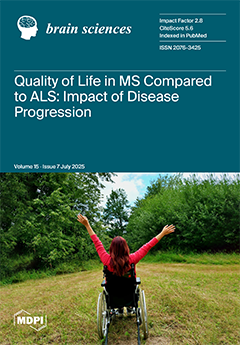Objectives: To investigate whether a Multimodal Rehabilitation Program (MRP) affects the change in visual–spatial abilities, especially attention, information-processing speed, visual–spatial learning, the severity of depression, and strategies for coping with pain in Complex Regional Pain Syndrome (CRPS) participants.
Methods: The study
[...] Read more.
Objectives: To investigate whether a Multimodal Rehabilitation Program (MRP) affects the change in visual–spatial abilities, especially attention, information-processing speed, visual–spatial learning, the severity of depression, and strategies for coping with pain in Complex Regional Pain Syndrome (CRPS) participants.
Methods: The study was conducted between October 2021 and February 2023, with a 4-week rehabilitation program that included individual physiotherapy, manual and physical therapy, and psychological intervention such as psychoeducation, relaxation, and Graded Motor Imagery therapy. Twenty participants with CRPS and twenty healthy participants, forming a control group, were enlisted. The study was a 2-arm parallel: a CRPS group with MRP intervention and a healthy control group matched to the CRPS group according to demographic variables. Before and after, the MRP participants in the CRPS group were assessed for visual–spatial learning, attention abilities, severity of depression, and pain-coping strategy. The healthy control group underwent the same assessment without intervention before two measurements. The primary outcome measure was Reproduction on Rey–Osterrieth’s Complex Figure Test assessing visual–spatial learning.
Results: In the post-test compared to the pre-test, the participants with CRPS obtained a significantly high score in visual–spatial learning (
p < 0.01) and visual information-processing speed (
p = 0.01). They made significantly fewer omission mistakes in visual working memory (
p = 0.01). After the MRP compared to the pre-test, the CRPS participants indicated a decrease in the severity of depression (
p = 0.04) and used a task-oriented strategy for coping with pain more often than before the rehabilitation program (
p = 0.02).
Conclusions: After a 4-week MRP, the following outcomes were obtained: an increase in visual–spatial learning, visual information-processing speed, a decrease in severity of depression, and a change in the pain-coping strategies—which became more adaptive.
Full article






